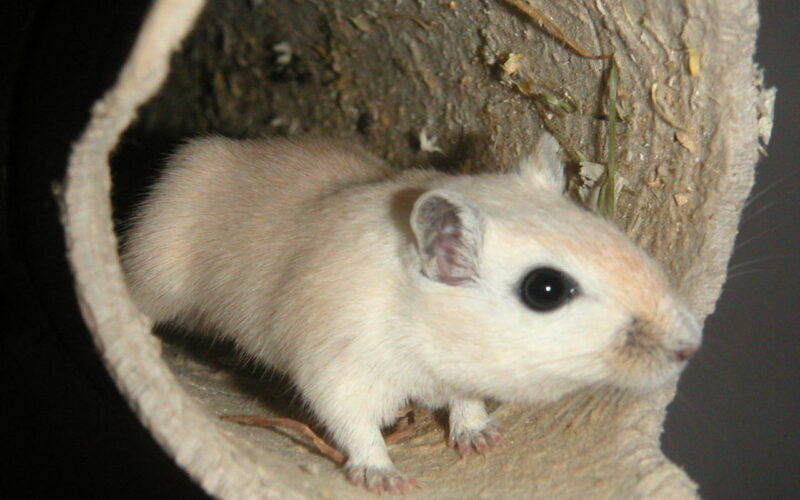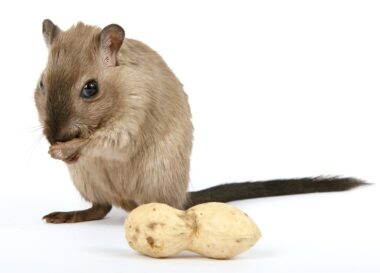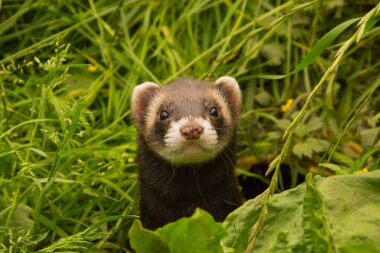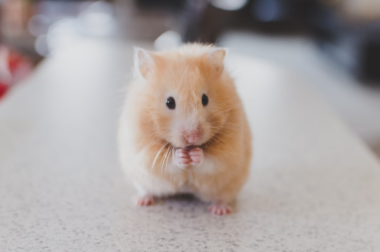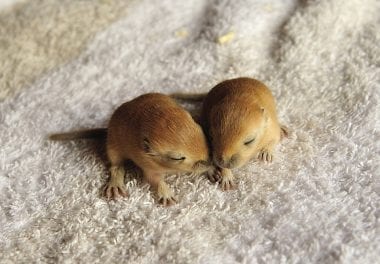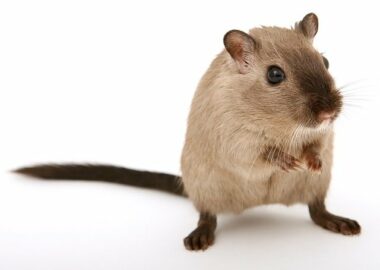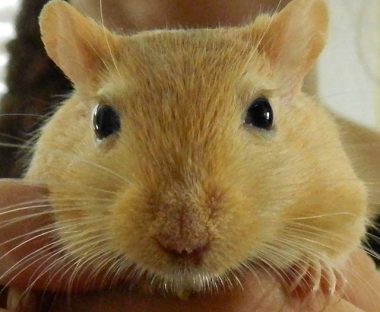A gerbil is simply known as a desert rat, and there are many species of the animal in Africa, India, and Asia. So, what does a gerbil look like? Well, Gerbil looks very similar to a small rat and is well adapted to arid habitats, and it is a lovable small mammal that belongs to the order Rodentia.
The Cute Little Gerbil
Gerbils look very similar to the mouse and the hamster, but they aren’t rats, though both rats and gerbils are rodents. The small rodents have furry bodies with long, fur-covered tails. They are about four to five inches long and weigh around 2 and 5 ounces, and the tails can add another 4 inches to their length. The males are slightly larger than females and weigh more than the females.
The body of the animal is covered with a thick coat of fur, which is soft in some and harsh in others. The neutral colors of the body fur allow the animal to blend in with its surroundings. They have an overall grayish color in the wild, but through selective breeding, one does come across color variations such as white, black, and gold.
Most species have long and narrow back feet that help the animal jump. They have small ears, but some species may have longer ears.
Now that you have somewhat a good idea of what does a gerbil look like let us learn a bit more about this interesting rodent.
The Scientific Names
Different species of Gerbils have different scientific names, but all those species belong to the Muridae family and the Gerbillinae subfamily. The most common is the Mongolian gerbils, and their scientific name is Meriones unguiculatus which means “clawed femur” in Greek. The scientific name of fat-tailed Gerbil is Pachyuromys duprasi, which means fat-tailed mouse in Greek.
Some scientific names of other species include Gerbillus pulvinatus, Gerbilliscus leucogaster, Meriones rex, Brachiones przewalskii, Ammodillus imbellis, Dipodillus harwoodi and more.
Most species live in dry, rocky areas and some of the species are endemic to one country. For example, Cape Gerbil is found only in South Africa while Przewalski’s Gerbil is found only in China, while the rupicolous Gerbil is endemic to Mali.
The Habitat
Gerbils prefer to live in deserts, grassland, and shrubland that are covered with grasses, herbs, and shrubs. China, Mongolia, and Russian steppes are their favorite habitat as the winters are cool and dry while the summers are hot. The sandy plains of Africa, Asia, and the Middle East are the species’ natural habitat. The desert rat has been introduced to North America and other countries commercially in recent years.
Most Gerbils species are diurnal and remain active during the day and night. However, there are some exceptions such as Cheesman’s Gerbil in the Middle East and Boehm’s Gerbil in Africa., which are nocturnal.
Predators and threats for wild gerbils include owls, foxes, and snakes. In some countries, they can be hunted by humans for their furs, and because of climate change and hunting, some of the species have become endangered. The rodents use their long tails as a self-defense mechanism to escape from their predators. As the long tail is almost as long as the Gerbil’s body, it is used by the animal for balance when standing on its hind legs. However, the length of the tail can vary based on individual gerbil species.
The behaviors
Gerbils are active animals who are curious playful and can be seen sitting up on their hind legs. The animals prefer to live in groups in an underground burrow with 10–20 exits, and they use deeper burrows to escape from their predators. Often, the burrows of one group may be interconnected with the other group. They can live for about two to three years on average, while some can live up to 8 years.
Next to the beaver, gerbils are the most well knows gnawers. They use their sharp claws to build burrows underground and use those extensive networks of tunnels for safety and to hide as well as bred in. The rodents only come out of their burrows when looking for food and water. Females give birth to four to seven pups that develop quickly. They are weaned, mature, and independent when they’re a month old.
Gerbil are omnivorous and can eat both plant and animal material. The wild gerbils love to gnaw and prefer to eat seeds, flowers, leaves, grass, nuts, roots, and insects. If they find newly hatched eggs, chicks, and insects, they will eat those.

Popular gerbil species
As mentioned before, there are several different kinds of gerbils and their species globally. However, some species are more common than others, such as Mongolian Gerbil, Fat-tailed Gerbils, Pallid Gerbils, Great Gerbils, and Shaw’s jird.
- Mongolian Gerbil – This is the most common Gerbil you will come across in pet shops. They look like a typical gerbil with a medium coat, large, black eyes, and a long, thin tail. Mongolian gerbils have been selectively bred and carry various coat colors such as black, Burmese, grey agouti, light red fox, silver nutmeg, ivory cream, etc.
- Fat-tailed Gerbils – Fat-tailed gerbils are fast gaining popularity in pet stores, and they differ from Mongolian Gerbils solely because of their tail. They have a short thick club-shaped tail which is used by the species to store fat and water. Gerbils with fatter tails are seen as an indication of good health. They have soft, fluffy fur in yellow-gray patterns.
- Pallid Gerbils – Pallid gerbils hail from Egypt and look very similar to the Mongolian Gerbil. The only difference is that they have shorter bodies and long tails. A thin layer of pale orange fur covers their bodies, and these gerbils are also referred to as Shaw’s jird and great Gerbil.
- Great Gerbils – The great Gerbil is one of the largest species in the family and thence the name. They are larger in size, more revive, and not preferred as pets, and are known for their voracious appetites. In fact, the great Gerbil looks more like the Midwestern prairie dog and doesn’t carry the cute mouse-like appearance.
- Shaw’s jird – Shaw’s jird is another large-sized gerbil, and it differs from the Great Gerbils in being cute and mouse-like. Their body is covered with fine black or tan fur on top, and the tail is long and fluffy; they look attractive as pets. They are not as friendly as other pet gerbils on the list but are still popular as pets because of their docile behaviors.
Gerbils have been used in scientific research for many centuries now, and it is only in recent times that they are seen and kept as pets. Expanding on what a gerbil looks like, it would be interesting to know how Gerbils behave as a pet, away from the wild.
As a Pet
Gerbils are social and friendly animals, and with regular and gentle handling, it is easy to tame them. They are very social animals and are easy to care for. Moreover, they are relatively inexpensive and need a fairly simple diet. They are relatively quiet as pets but can remain active during the day as well as at night.
As they prefer to live in groups, keeping a solitary gerbil as a pet is not advisable. Hence, keep a same-sex pair if planning to keep gerbils as pets, and it is advisable to get younger gerbils so that they can grow up together. As these animals are quite territorial, keeping them away from other household pets is strongly recommended to avoid stress, fights, and injury.
The enclosures should be large and practicable for these active animals. One should never put the enclosure or the aquarium in direct sunlight.
If you have Gerbils as pets, spend some time with them every day to develop that bond. Keep their environment clean; keep them in a glass aquarium as it allows the animal to engage in their natural burrowing behavior. Cover the aquarium with a secure mesh lid to allow good ventilation and prevent any escape attempts.
The Primary Diet of Gerbil
Gerbil’s diet is simple, and formulated pelleted food is available in the market. You can also offer your pet a mix of seeds, grains, and dried veggies. You should feed your pet gerbil every 1 to 2 weeks.
Pellets are a better choice as the animal can’t be picky, and occasionally, treats can be given to train and tame a gerbil. Discuss the animal’s diet, quantity, and handling with your vet. Also, it is of utmost importance to provide fresh water to your pet and change the water daily.
Gerbils make good pets provided they are properly cared for. All they need is a suitable enclosure with the right temperature and space, fresh and clean food and water, and something to keep them busy.
Gerbils are very playful and will need plenty of exercises to keep them physically stimulated and fit. You can place some toys in their enclosure and fit in an exercise wheel to keep them busy and active. It is a good idea to give them some time out of their aquarium and let them run and explore a secure area under supervision.
Now that you know what does a gerbil look like and know about the habitat and behaviors, go ahead and learn more about the fascinating, cute animal!
